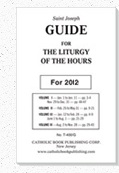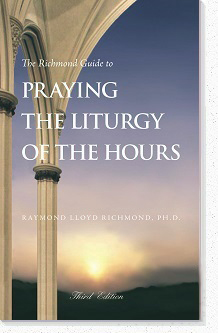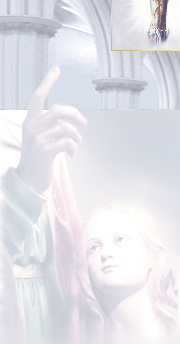|
|
|
Learning How to Pray |
Spiritual Counsels |
Books |
About CSF
Introduction |
Preliminary Remarks: Sections
of the LOH, Glory to the Father,
Postures, Sign of the Cross,
Signs of Reverence, Languages
| Complete Instructions
 UR LORD Jesus
Christ told us to pray constantly (Luke 18:1). The Liturgy of the Hours (or
The Divine Office) provides one way to fulfill this obligation in
a structured format. Moreover, the mandate of the Liturgy of the Hours applies
not only to all bishops and priests, other sacred ministers, and the religious,
but also to the laity. But, for the laity especially, without clear
and unambiguous instructions, praying the Liturgy of the Hours can be confusing
and difficult. UR LORD Jesus
Christ told us to pray constantly (Luke 18:1). The Liturgy of the Hours (or
The Divine Office) provides one way to fulfill this obligation in
a structured format. Moreover, the mandate of the Liturgy of the Hours applies
not only to all bishops and priests, other sacred ministers, and the religious,
but also to the laity. But, for the laity especially, without clear
and unambiguous instructions, praying the Liturgy of the Hours can be confusing
and difficult.
Introduction
Actually, everything you need
to learn the format of the Liturgy of the Hours can be found in the volumes
themselves.
• |
The General Instruction of the
Liturgy of the Hours (GILH) can be found in Volume I of the four-volume set.
It can also be found online:
General
Instruction of the Liturgy of the Hours. |
• |
The section called the
Ordinary in each volume provides complete instructions for the entire
office. |
Nevertheless, “digesting”
all this information can be difficult for someone without a liturgical
background, and this fact alone can prevent many persons from learning a
beautiful form of Catholic prayer. Still, everything is really much more
simple than it seems. Once you have “walked through
it” a couple times and catch on to the basic concepts you will find
yourself moving through the Hours with ease and confidence.
 It can be helpful to use the
St. Joseph Guide for the Liturgy of the Hours, a small booklet that serves
the entire calendar year. You should be able to buy the guide in any good Catholic
bookstore, or direct from the
publisher’s
website. It’s available for both the four-volume set and the one-volume
Christian Prayer. It can be helpful to use the
St. Joseph Guide for the Liturgy of the Hours, a small booklet that serves
the entire calendar year. You should be able to buy the guide in any good Catholic
bookstore, or direct from the
publisher’s
website. It’s available for both the four-volume set and the one-volume
Christian Prayer. |
Preliminary
Remarks
Note that the Liturgy of
the Hours has been designed to be sung in community; however, the words recited,
said, and sung can be interchanged, and so it is allowable to “recite”
the hours by “saying” them without singing. In individual recitation, the hours can
simply be read—that is, “said”—silently.
Each volume
of the Liturgy of the Hours has several basic
sections:
• |
The
Proper of Seasons is found at the beginning
of each volume. It follows a one-year cycle beginning with Advent and progressing
through Christmas, Ordinary Time, Lent, Easter, and another period of Ordinary
Time. It contains material specific to each day of the current season.
|
• |
The
Ordinary contains the basic instructions
for each celebration: the invitatory, the Office of Readings, Morning Prayer,
Daytime Prayer, Evening Prayer, and Night Prayer. |
• |
The
Psalter contains all the basic psalms,
readings, and intercessions.
|
• |
Night
Prayer follows a simple daily cycle through the week. |
• |
The
Proper of Saints contains material specific
to celebrations of various holy days (memorials, feasts, and solemnities)
throughout the year. |
• |
The
Common of Saints contains material common
to celebrations of various kinds of saints: martyrs, pastors, virgins, and
so on. |
Locate each section
of your volume and place a ribbon there to mark the place for daily reference.
I keep the ribbons for the Ordinary and Night Prayer fixed,
since, when we need to go to those sections we always start at the beginning
of them, but I move the other ribbons as I progress through each day of
prayer.
Beginners often
ask, “How do I know which week of the Psalter we are in?”
To find out, just go to the Proper of Seasons and find the Sunday of the
current liturgical week (e.g., 9th Sunday of Ordinary Time) and right there
it will tell you which Psalter week to use. (If the Sunday of the week is
a special solemnity such as Christ the King that does not use the Psalter,
then look to the following Monday.) |
Throughout
the Liturgy of the Hours, every psalm and canticle is concluded with the
Glory to the Father unless otherwise indicated.
• |
Glory to the Father, and to the
Son, and to the Holy Spirit:
As it was in the beginning, is now, and will be for ever. Amen. |
• |
The recitation of each psalm
(or canticle) therefore takes this order: antiphon, psalm, Glory to the
Father, psalm prayer, and antiphon. |
Postures during
the Office:
• |
All taking part stand
(a) during the introduction to the Office and the introductory verses of
each hour; (b) during the hymn; (c) during the Gospel Canticle; (d) during
the intercessions, the Lord’s Prayer, and the concluding prayer
(GILH 263). |
• |
All should sit to listen
to the readings (GILH 264). |
• |
When the psalms and canticles
are said, the assembly either sits or stands according to local
custom (GILH 265). |
• |
In individual, private recitation
you may use whatever posture(s) you prefer, including sitting through the
entire Office. |
Making the
Sign of the Cross during the Office:
• |
All make the sign of the cross,
from forehead to breast and from left shoulder to right (a) at the beginning
of the Hours, when God, come to my
assistance is being said; (b) at the beginning of the Gospel Canticles
of Zechariah, of Mary, and of Simeon (GILH
266). |
• |
The sign of the cross is made
with the thumb on the mouth at the beginning of the invitatory, at the words
Lord, open my lips (GILH
266). |
• |
The sign of the cross can be
made at the dismissal/final blessing. (The GILH does not say anything
specific about this.) |
Sign of reverence
during the Office:
• |
A bow of the head is made when
(a) the three Divine Persons are named (e.g., Glory to the Father and to the Son,
and to the Holy Spirit), (b) at the name of Jesus, (c) at the name of the Blessed
Virgin Mary, and (d) at the name of the Saint in whose honor the Liturgy of the Hours
may be celebrated that particular day. (See
Ceremonial of Bishops, 68; General Instruction of the Roman Missal,
275). |
Languages
during the Office:
• |
Different languages may be used for
various parts at one and the same celebration (See GILH 276)
(e.g., saying the Gospel Canticle of Mary [Magnificat] and the
Lord’s Prayer [Pater Noster] in Latin during a celebration otherwise in
English). |

COMPLETE INSTRUCTIONS
The Richmond Guide to
Praying the Liturgy of the Hours
 THIS
BOOK has organized all the information you will need to learn to
pray the Liturgy of the Hours using the four-volume set, step-by-step, as
simply as possible. (The single-volume Christian Prayer follows the same
basic format, but with simplifications.)
THIS
BOOK has organized all the information you will need to learn to
pray the Liturgy of the Hours using the four-volume set, step-by-step, as
simply as possible. (The single-volume Christian Prayer follows the same
basic format, but with simplifications.)
This new third edition contains
comprehensive instructions for praying the Office of Readings, Morning
Prayer, Daytime Prayer, Evening Prayer, and Night Prayer on weekdays, Sundays,
Memorials, Feasts, and Solemnities; plus, this edition contains the following
material not in the first edition:
• |
Detailed information
about how celebrations differ in ordinary time, in Advent, and in the Easter
season. |
• |
Detailed graphic
charts for all of the celebrations as they vary by liturgical season. |
• |
“Walk-through”
examples to lead you step-by-step through the celebration of a Memorial,
a Feast, a Solemnity, and a Sunday in Advent. |
|




 It can be helpful to use the
St. Joseph Guide for the Liturgy of the Hours, a small booklet that serves
the entire calendar year. You should be able to buy the guide in any good Catholic
bookstore, or direct from the
It can be helpful to use the
St. Joseph Guide for the Liturgy of the Hours, a small booklet that serves
the entire calendar year. You should be able to buy the guide in any good Catholic
bookstore, or direct from the
